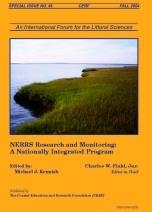Understanding the circulation and exchange rates of water masses in an estuary is critical to understanding the movement and recruitment patterns of planktonic propagules and how these patterns relate to the distribution and abundance of adults. Forests of bull kelp (Nereocystis luetkeana) are complex three-dimensional habitats that can support tightly linked trophic interactions between primary producers, herbivores, and carnivores. Therefore, the spatial distribution of this important habitat can affect local food webs. Kelp forests in Kachemak Bay, Alaska, were mapped from 2000 to 2002 using low-altitude aerial photography. Over the 3 years, kelp forests were found only in the outer basin, and only a few attached sporophytes were found in the turbid and lower-salinity inner basin. Many biotic and abiotic factors can affect the dispersal and development of kelp. We tested the hypothesis that decreased salinity and light intensity in the inner basin limit the spatial distribution of Nereocystis sporophytes in this system. Transplant experiments were conducted between the marine and estuarine endpoints of kelp forest distribution. These experiments suggest that the growth of Nereocystis sporophytes transplanted from the marine to the estuarine endpoint was impeded, but that they could survive under estuarine conditions. We tested a second hypothesis, that estuarine circulation patterns control Nereocystis sporophyte distribution. Hydrographic measurements and circulation studies suggest that a strong baroclinic jet develops in the late summer and fall and may prevent Nereocystis spore dispersal into the inner basin. The cyclonic surface circulation in the outer basin may contribute to the observed spatial distribution of kelp forests in this system.
BioOne.org will be down briefly for maintenance on 12 February 2025 between 18:00-21:00 Pacific Time US. We apologize for any inconvenience.
How to translate text using browser tools
1 November 2004
The Role of Estuarine Hydrodynamics in the Distribution of Kelp Forests in Kachemak Bay, Alaska
G. Carl Schoch,
Héloïse Chenelot
ACCESS THE FULL ARTICLE

Journal of Coastal Research
Vol. 2009 • No. 10045
Fall 2004
Vol. 2009 • No. 10045
Fall 2004
baroclinic currents
distribution
estuarine circulation
fjords
light intensity
Nereocystis luetkeana
salinity gradient




